If you are looking for a new seven-seater SUV for your family which are the safest? As a parent, our children's safety is at the forefront of our minds and never more so than when buying our new family car.
- Looking for the top 10 safest family cars for kids as rated by ANCAP?
- Looking for seven-seaters that will take three child seats across?
With lots of new seven and eight-seater family SUVs gaining five-star ANCAP ratings, I have put together this helpful list of the top ten safest family cars for kids that have performed best in the new ANCAP crash testing that includes child dummies.
1 – 2023 Ford Everest – Score 93% for Child Occupant Protection
The 2023 Ford Everest seven-seater SUV is a fantastic family SUV.
2023 Ford Everests, with a build date of May 2022 onward, score a 93% ANCAP score for child occupant protection. In the crash tests, they scored full points for both the frontal offset crash and the side impact test. For restraint installation, the Ford Everest scored 11.66 out of 12. The Everest scored 10 out of 13 for on-board safety features. For now, this makes it the safest family car for kids on sale in Australia.
The 2023 Ford Everest scored:

ANCAP wrote of the 2023 Ford Everest testing:
In the frontal offset and side impact tests, protection of the 10 year and 6 year dummies was GOOD and maximum points were scored in both of these tests.
The Ford Everest is fitted with lower ISOFix anchorages in the outboard seats of the second row, and top tether anchorages on all second and third row seats.
Installation of typical child restraints available in Australia and New Zealand showed that all of the selected child restraints could be accommodated in most rear seating positions, however the Type A rearward facing capsule could not be correctly installed in the second row centre and both of the third row seating positions.
The 2023 Ford Everest has nine airbags as standard:
Dual frontal, side chest-protecting and side head-protecting (curtain) airbags for all three seating rows, and driver and passenger knee airbags are standard. A centre airbag which provides added protection to front seat occupants in side impact crashes is also standard.
There are also pretensioner seatbelts in the first and second-row outer seats (these are beneficial once your children are out of fully harnessed child seats).

The ANCAP child restraint fitting charts below show which types of child seats were able to be safely installed in each row of seats of the 2023 Ford Everest:

We also have to take the safety of the front passengers into account when choosing our new family car, and the 2023 Ford Everest didn't do as well in this, with a score of 32.99 out of 38 or 86% for Adult Occupant Protection. Scoring 7.36 out of 8 for the full-width frontal crash test, 5.28 out of 8 for the frontal offset crash test, full marks for the side impact test and 5.15 out of 6 for the oblique pole test. Scoring 3.19 out of 4 for whiplash protection, full marks for far side impact and rescue and extraction.

2 – Jeep Grand Cherokee – Scores 93% for Child Occupant Protection
The Jeep Grand Cherokee is a large seven-seater SUV.
Jeep Grand Cherokees sold from February 2023 onwards scored 93% for child occupant protection, 45.89 out of 49 points. In the crash tests, it scored full points for both the Dynanic Front Test and the Dynamic Side Test. The Grand Cherokee also got 11.89 out of 12 for child restraint installation and 10 out of 13 for on-board safety features.

ANCAP wrote of the testing:
In the frontal offset and side impact tests, protection of the 10 year and 6 year dummies was GOOD and the Jeep Grand Cherokee scored maximum points in these tests.
The Jeep Grand Cherokee is fitted with lower ISOFix anchorages on all seating positions in the second row of seats, and top tether anchorages for all rear seating positions.
Installation of typical child restraints available in Australia and New Zealand showed most child restraints could be accommodated the rear seating positions, however the Type A capsule could not be correctly installed in the second row centre seating position using the seat belt.
The Jeep Grand Cherokee has nine airbags as standard:
Dual frontal, side chest-protecting, side head-protecting (first, second, and third rows where applicable), and a driver and passenger knee airbag are standard. A centre airbag to prevent occupant-to-occupant interaction is not available.
There are also pretensioner seatbelts in all the first and second-row seats (these are beneficial once your children are out of fully harnessed child seats).
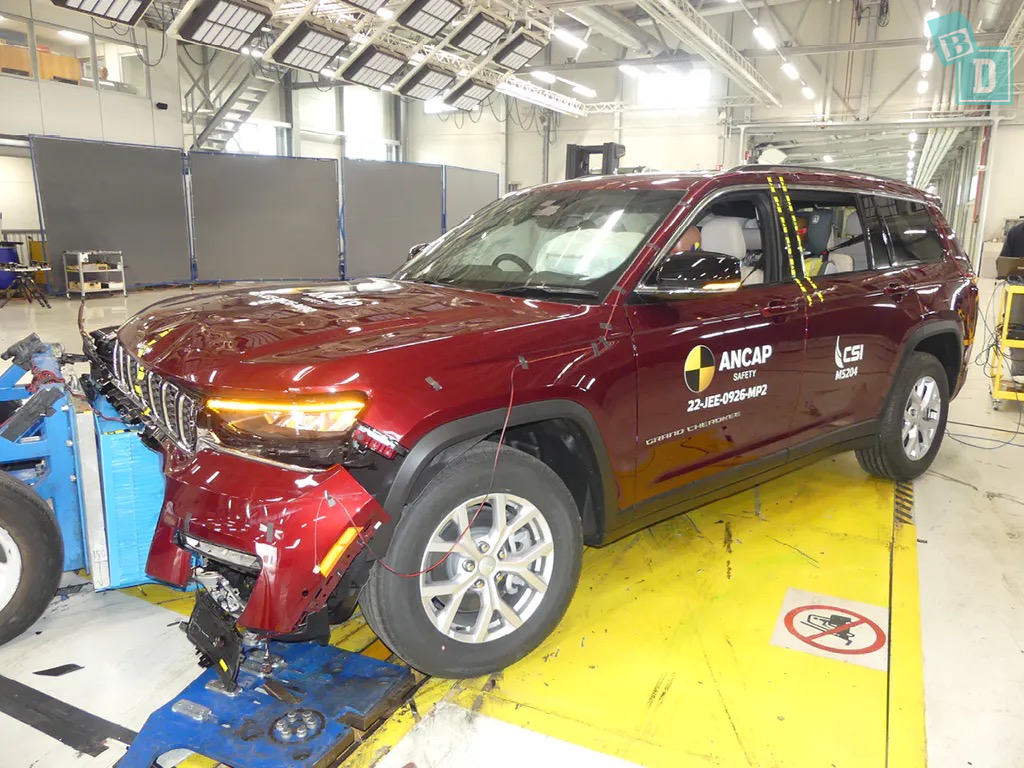
This ANCAP child restraint fitting chart shows which types of child seats were able to be safely installed in the second-row seats of the Jeep Grand Cherokee:

We also have to take the safety of the front passengers into account when choosing our new family car, and the Jeep Grand Cherokee didn't do as well in this, with a score of 36.64 out of 31.83 or 83% for Adult Occupant Protection with 7.61 out of 8 for the full-width frontal crash test, 5.89 out of 8 for the frontal offset crash test and full marks for both the side impact and pole test. Scoring 3.34 out of 4 for whiplash protection, 1.99 out of 4 for far side impact and 1 out of 2 for rescue and extraction.

3 – Nissan Pathfinder – Scores 93% for Child Occupant Protection
The Nissan Pathfinder is available as a seven or eight-seater family SUV.

Nissan Pathfinders with a build date of July 2022 onwards, scored 93% for child occupant protection, 45.80 out of 49 points. In the crash tests, it scored full points for both the dynamic front and dynamic side tests. The Nissan Pathfinder also got 11.80 out of 12 for child restraint installation and 10 out of 13 for on-board safety features. Making it a safe choice for your rear passengers.

ANCAP wrote of the testing:
In the frontal offset and side impact tests, protection of the 10 year and 6 year dummies was GOOD and maximum points were scored in these tests.
The Nissan Pathfinder is fitted with lower ISOFix anchorages and top tether anchorages on all three seats in the second row and also in the left seat of the third row.
Installation of typical child restraints available in Australia and New Zealand showed most child restraints could be accommodated in most rear seating positions, though one of the selected Type A convertible restraints and one Type B convertible restraint could not be correctly installed using the third row ISOfix anchorages.
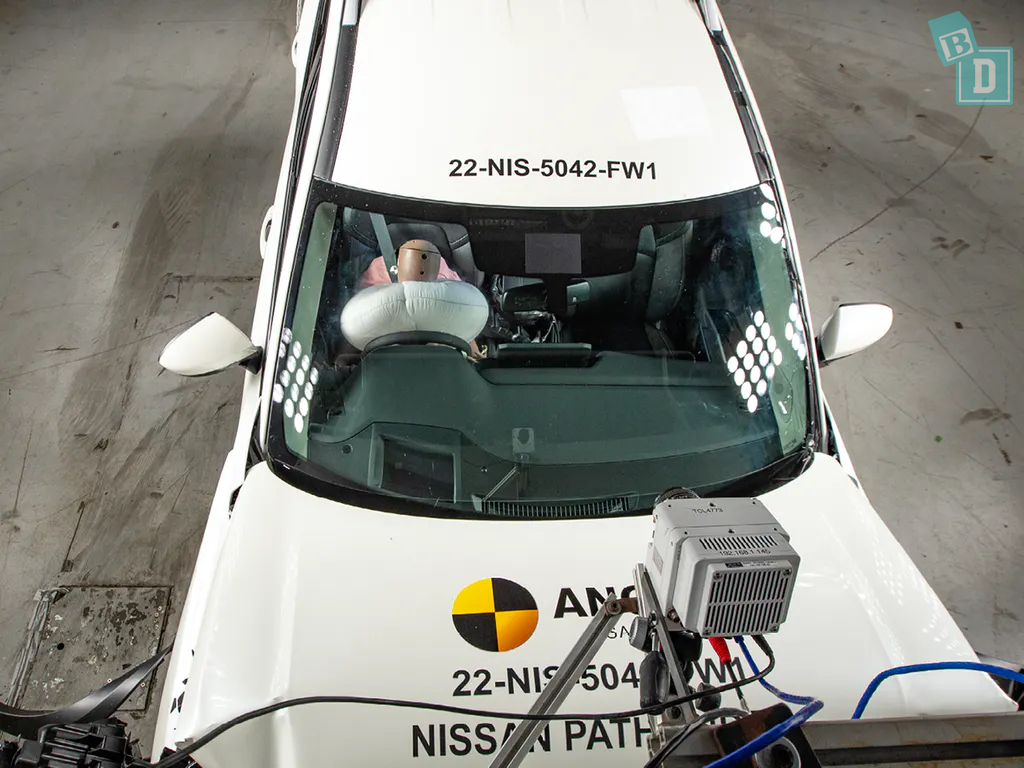
The Pathfinder has seven airbags as standard:
Dual frontal, side chest-protecting and side head-protecting airbags (all three rows) are standard. A centre airbag which provides added protection to front seat occupants in side impact crashes is also standard.
There are also pretensioner seatbelts in the first and second-row outer seats of the Nissan Pathfinder (these are beneficial once your children are out of fully harnessed child seats).

This ANCAP child restraint fitting chart shows which types of child seats were able to be safely installed in the second-row seats of the Nissan Pathfinder:
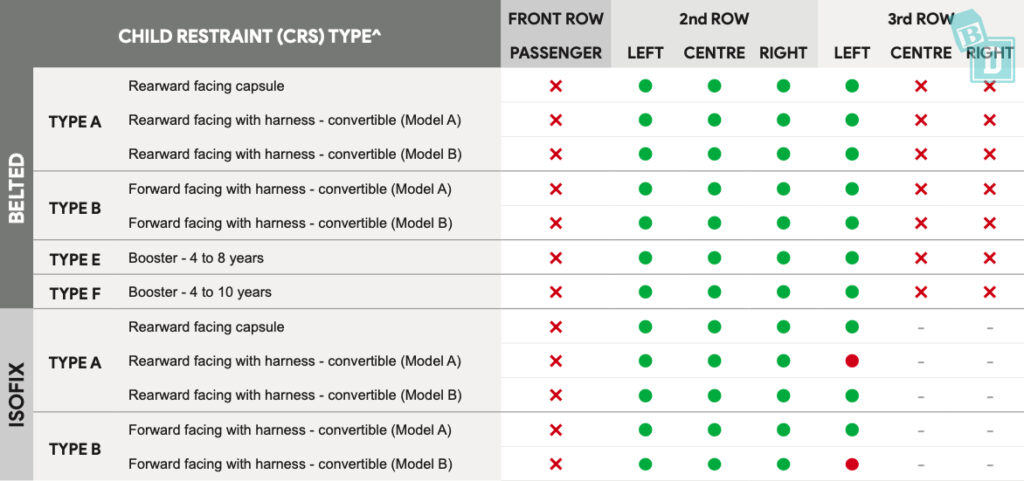
We also have to take the safety of the front passengers into account when choosing our new family car, and the Nissan Pathfinder did reasonably well in this, with a score of 32.87 out of 38 or 86% for Adult Occupant Protection with 6.67 out of 8 for the full-width frontal crash test, 6.53 out of 8 for the frontal offset crash test, full marks for both the pole test and the side impact test. Scoring 3.34 out of 4 for whiplash protection 3.33 out of 4 for far side impact and 1.00 for rescue and extraction.

4 – Mitsubishi Outlander – Scores 92% for Child Occupant Protection
The Mitsubishi Outlander is available as a five-seater or seven-seater family SUV and it is worth noting the third-row seats are not tested in ANCAP COP crash testing.
Mitsubishi Outlanders with a build date of July 2021 onwards scored 92% for child occupant protection, 45.43 out of 49 points. In the crash tests, it scored full points for both the frontal offset crash and for the side impact test. The Outlander also got 11.43 out of 12 for child restraint installation and 10 out of 13 for on-board safety features.

ANCAP wrote of the testing:
In the frontal offset and side impact tests, protection of the 10 year and 6 year dummies was GOOD and maximum points were scored in these tests.
The Mitsubishi Outlander is fitted with lower ISOFix anchorages on the second row outboard seats and top tether anchorages for all second row seating positions. Top tethers are not available in the optional third row. Installation of child restraints in the third row is therefore not recommended.
Installation of typical child restraints available in Australia and New Zealand showed most child restraints could be accommodated in most second row seating positions, though in the centre rear position, one of the selected convertible seats could not be correctly installed in forward facing or rearward facing modes, and one of the selected booster seats could not be correctly installed.
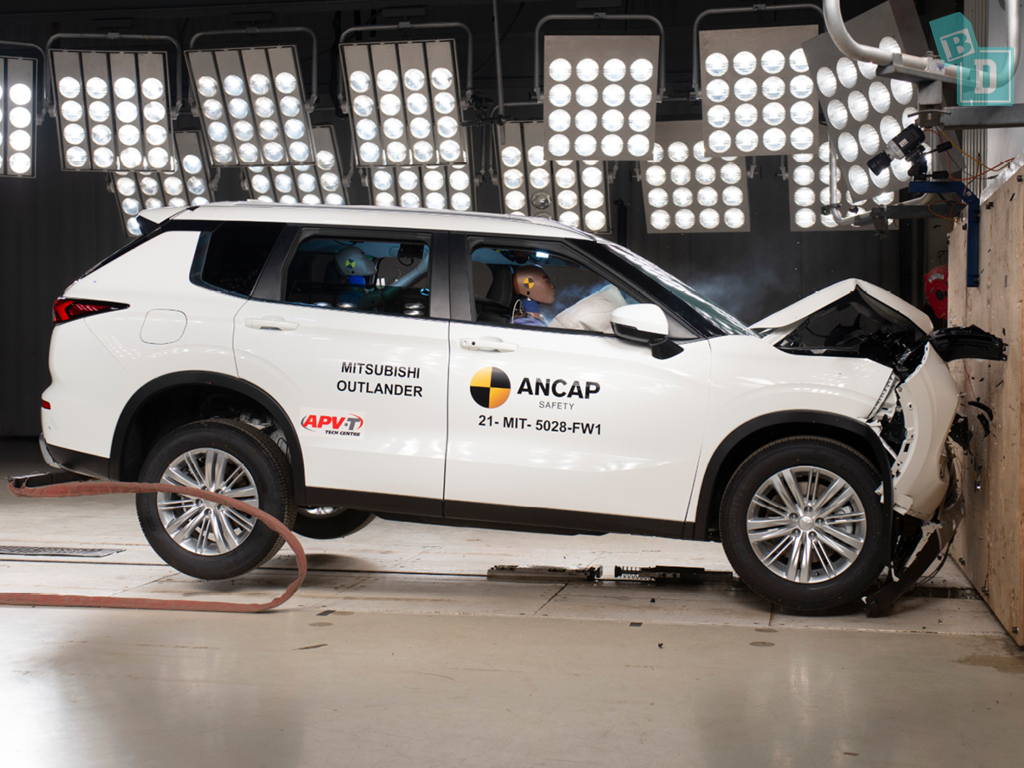
The Outlander has eight airbags as standard:
Dual frontal, side chest-protecting, and side head-protecting (curtain) airbags are standard. A centre airbag which provides added protection to front seat occupants in side impact crashes, as well as a driver knee airbag, are also standard on all variants.
There are also pretensioner seatbelts in the first and second-row outer seats (these are beneficial once your children are out of fully harnessed child seats).

This ANCAP child restraint fitting chart shows which types of child seat were able to be safely installed in the second-row seats of the Mitsubishi Outlander:

We also have to take the safety of the front passengers into account too when choosing our new family car and the Mitsubishi Outlander didn't do so well in this, with a score of 31.61 out of 38 or 83% for Adult Occupant Protection with 6.84 out of 8 for the full-width frontal crash test, 5.59 out of 8 for the frontal offset crash test, full marks for both the pole test and the side impact test. Scoring 3.18 out of 4 for whiplash protection, 3 out of 4 for far side impact and 1 out of 2 for rescue and extraction.
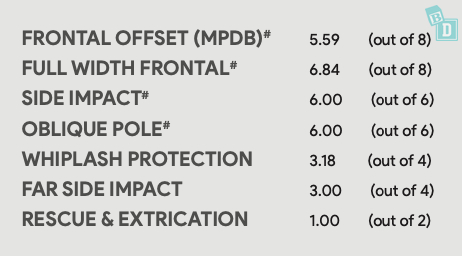
5 – Mercedes-Benz GLE – Scores 92% for Child Occupant Protection
The Mercedes-Benz GLE is a seven-seater SUV.

Mercedes-Benz GLEs with a build date of June 2019 onwards, scored 92% for child occupant protection, 45.24 out of 49 points. In the crash tests, it scored 15.24 out of 16 for the dynamic front test and full marks for the dynamic side test. The Mercedes-Benz GLE also got full marks for child restraint installation and 10 out of 13 for on-board safety features. Making it a safe choice for your rear passengers.

ANCAP wrote of the testing:
In the frontal offset test, readings of neck tension in the 10 year dummy indicated MARGINAL protection. Otherwise, protection of both the 6 year and 10 year child dummies was GOOD.
In the side impact test, protection was GOOD for both child dummies and maximum points were scored.
The Mercedes-Benz GLE is fitted with lower ISOFix anchorages on the second row outboard seats and top tether anchorages for all second row seating positions. Top tethers are not available in the optional third row. Installation of child restraints in the third row is therefore not recommended.
Installation of typical child restraints available in Australia and New Zealand showed that all of the selected child restraints could be accommodated in each of the second row seating positions and full points were scored for this assessment.
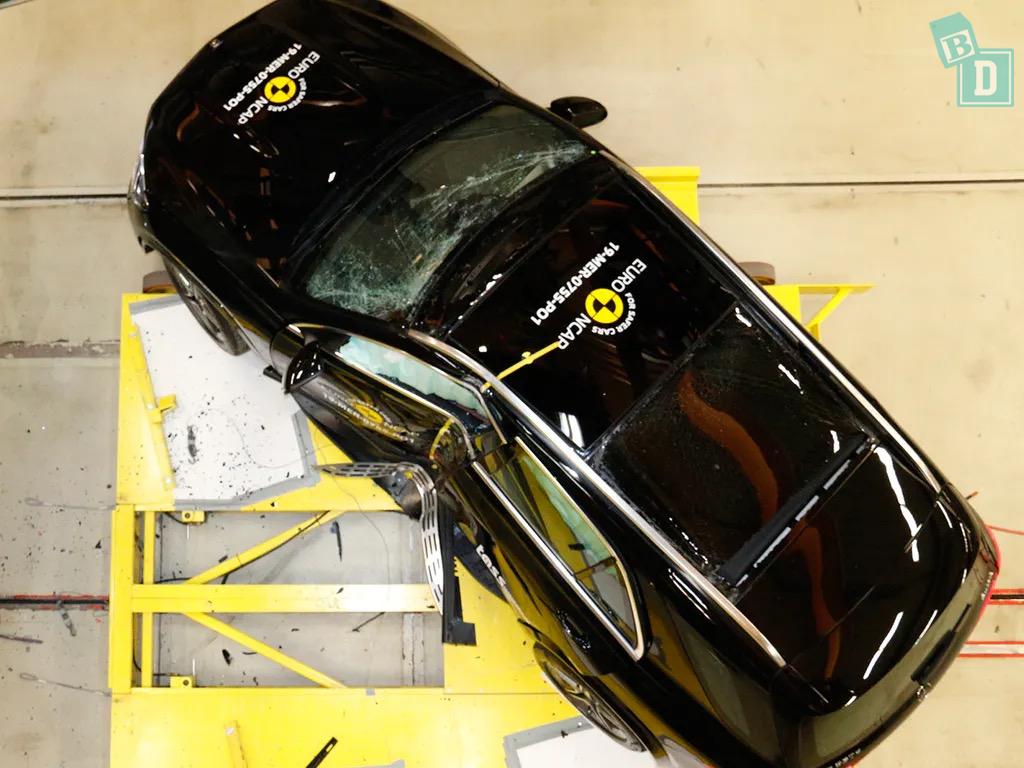
The Mercedes Benz GLE has seven airbags as standard:
Dual frontal, side chest-protecting airbags for front and second row outboard positions, side head-protecting airbags (curtains) for the front, second and optional third rows, and a driver knee airbag are standard.
There are also pretensioner seatbelts in the first and second-row outer seats of the Mercedes-Benz GLE and in the third-row seats (these are beneficial once your children are out of fully harnessed child seats).
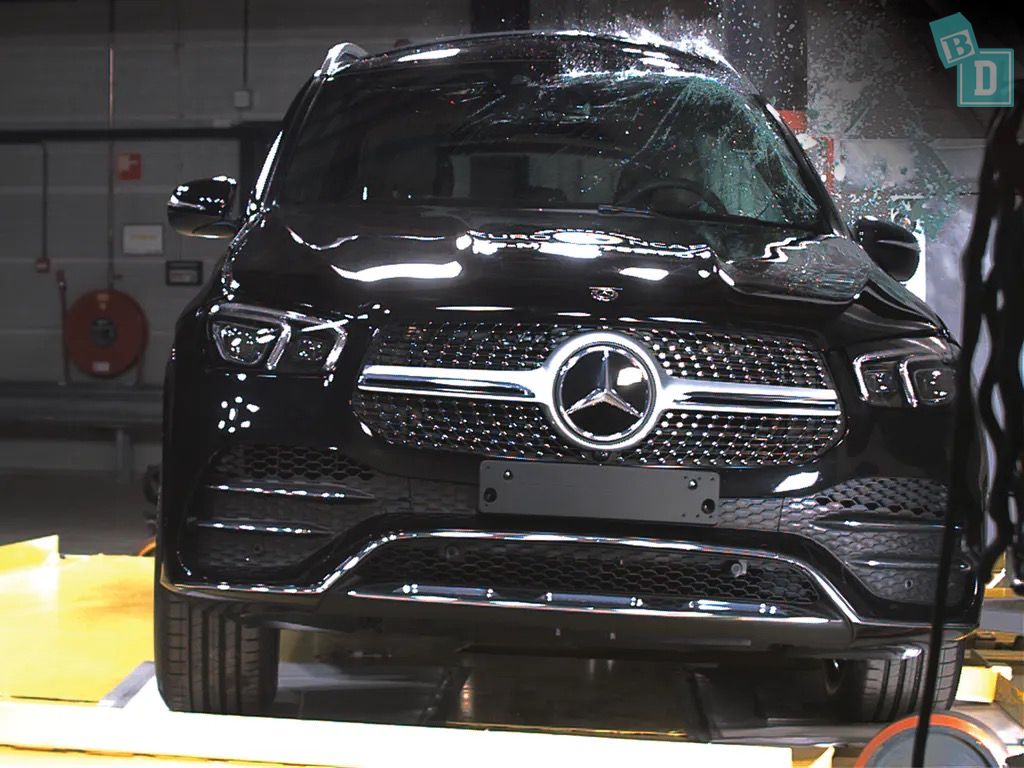
This ANCAP child restraint fitting chart shows which types of child seats were able to be safely installed in the second-row seats of the Mercedes-Benz GLE:

We also have to take the safety of the front passengers into account too when choosing our new family car, and the Mercedes-Benz GLE did very well in this, with a score of 34.93 out of 38 or 91% for Adult Occupant Protection with 7.71 out of 8 for the full-width frontal crash test, 7.32 out of 8 for the frontal offset crash test, full marks for the side impact test and 6.93 out of 8 the pole test. Scoring 1.76 out of 2 for whiplash protection and 3.21 out of 4 for AEB City.

6 – Hyundai Palisade – Scores 88% for Child Occupant Protection
The Hyundai Palisade is available as a seven or eight-seater family SUV.
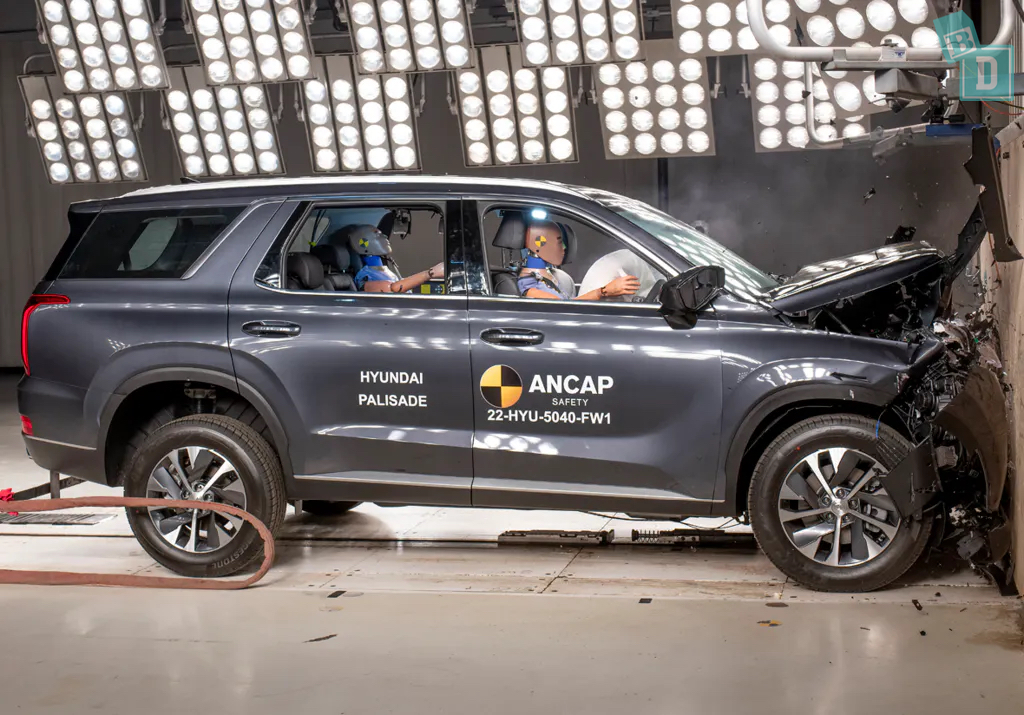
Hyundai Palisades with a build date of May 2022 onwards, scored 88% for child occupant protection, 43.24 out of 49 points. In the crash tests, it scored full points for both the dynamic front and dynamic side tests. The Hyundai Palisade also got 11.24 out of 12 for child restraint installation and 8 out of 13 for on-board safety features. Making it a pretty good choice for your rear passengers.

ANCAP wrote of the testing:
In both the frontal offset and side impact tests, protection was GOOD for all critical body areas for both the 6 year and 10 year child dummies.
The Hyundai Palisade is fitted with lower ISOFix anchorages on the second row outboard seats and third row left hand seat, and top tether anchorages for all second row seating positions and centre and left hand third row seating positions.
Installation of typical child restraints available in Australia showed all child restraints could be accommodated in the second row rear seating positions. However in the third row centre seat care is required to correctly install the Type F booster seat, and the Type E booster seat could not be correctly installed. In the third row left hand seat, the two selected convertible seats could not be correctly installed in forward or rearward-facing modes using the ISOfix anchorages.
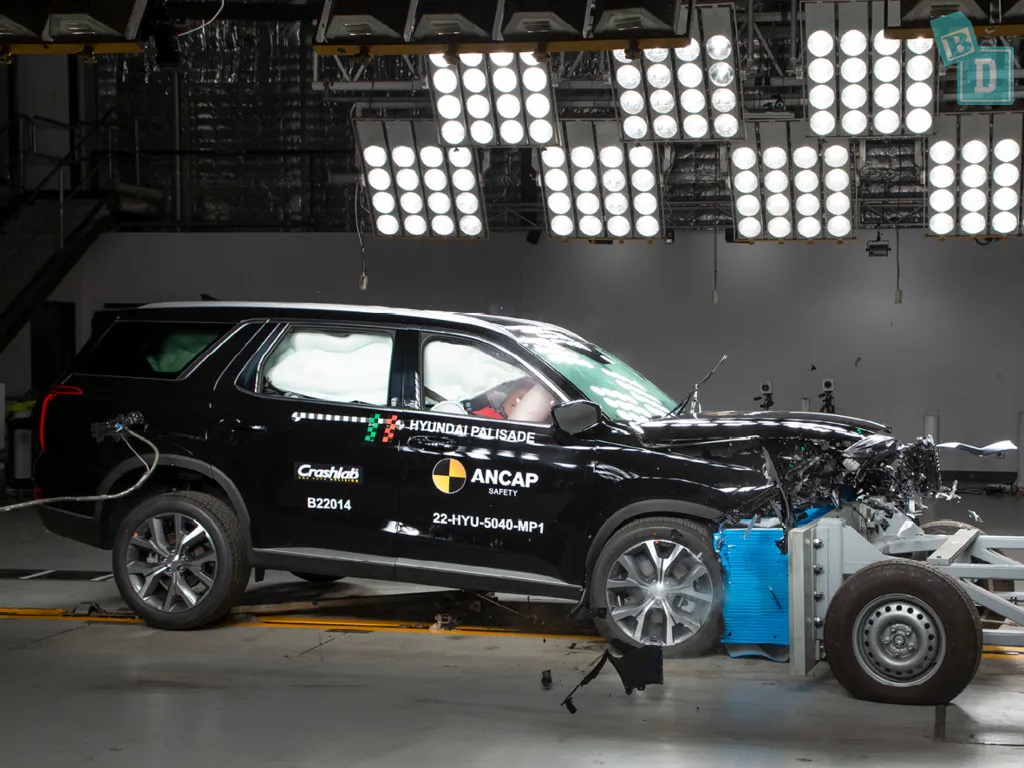
The Palisade has seven airbags as standard:
Dual frontal, side chest-protecting and side head-protecting (curtain) airbags are standard. A centre airbag to prevent occupant-to-occupant interaction is also available as standard.
There are also pretensioner seatbelts in the first and second-row outer seats of the Hyundai Palisade not in the third-row seats or second-row central seat (these are beneficial once your children are out of fully harnessed child seats).
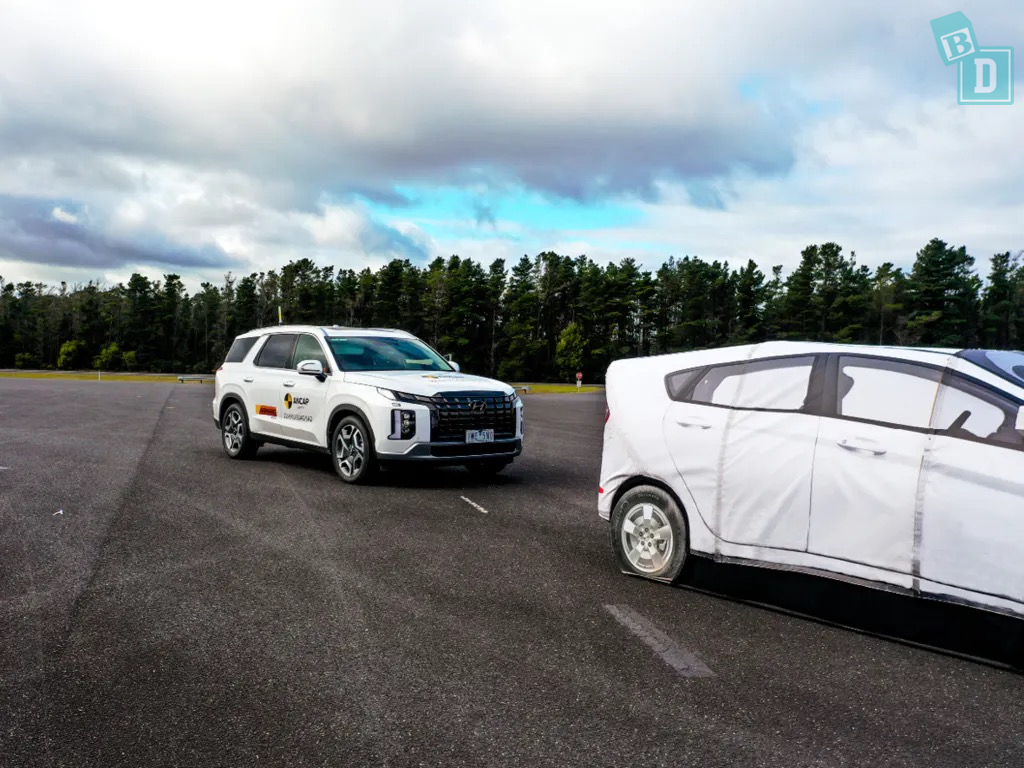
This ANCAP child restraint fitting chart shows which types of child seats were able to be safely installed in the second-row seats of the Hyundai Palisade:

We also have to take the safety of the front passengers into account when choosing our new family car, and the Hyundai Palisade scored similarly in this, with a score of 32.21 out of 38 or 84% for Adult Occupant Protection with 7.55 out of 8 for the full-width frontal crash test, 5.43 out of 8 for the frontal offset crash test, full marks for the side impact test and 5.45 out of 6 for the pole test. Scoring 2.77 out of 4 for whiplash protection 3.00 out of 4 for far side impact and full marks for rescue and extraction.

7 – Toyota Landcruiser 300 Series – Scores 88% for Child Occupant Protection
The Toyota Landcruiser 300 Series is a large seven-seater SUV.
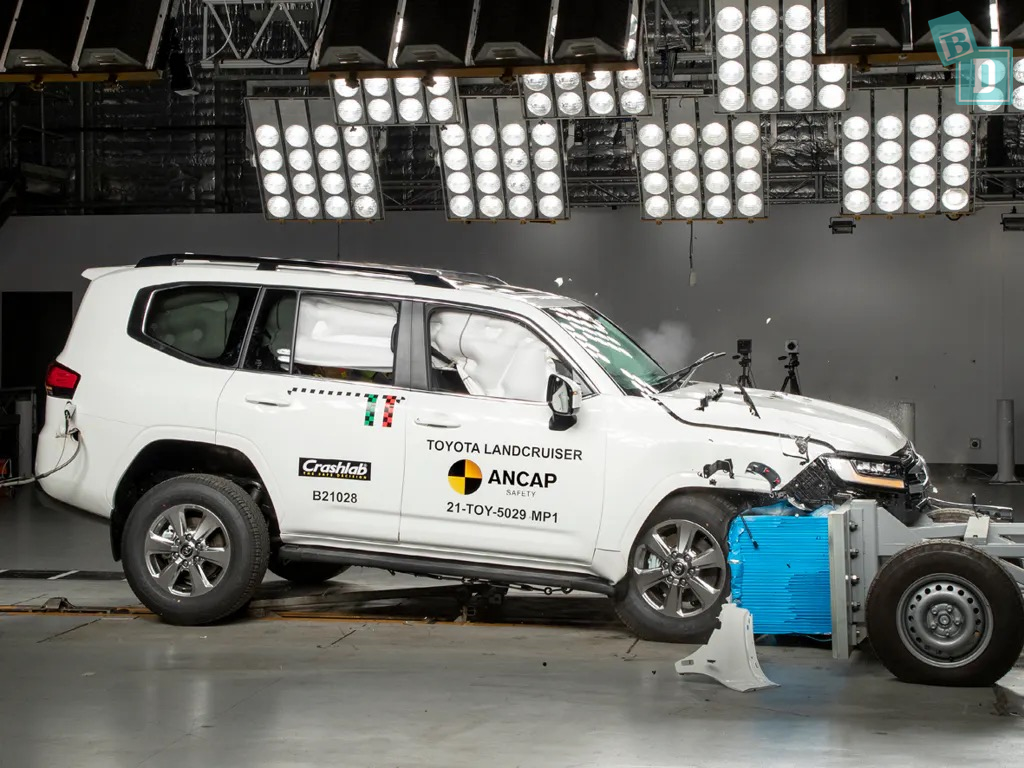
Toyota Landcruiser 300 Series‘ with a build date of July 2021 onwards, scored 88% for child occupant protection, 43.60 out of 49 points. In the crash tests, it scored full points for both the dynamic front and dynamic side tests. The Toyota Landcruiser 300 Series also got 11.60 out of 12 for child restraint installation and 8 out of 13 for on-board safety features. Making it a safe choice for your rear passengers.

ANCAP wrote of the testing:
In both the frontal offset and side impact tests, protection was GOOD for all critical body areas for both the 6 year and 10 year child dummies.
The Toyota LandCruiser is fitted with lower ISOFix anchorages on the second row outboard seats and top tether anchorages for all second row seating positions. Top tethers are not available in the third row and installation of child restraints is not recommended in these seating positions.Installation of typical child restraints available in Australia and New Zealand showed most child restraints could be accommodated in most second row seating positions, though one of the selected Type A convertible seats could not be correctly installed in rearward facing mode using the ISOfix anchorages.
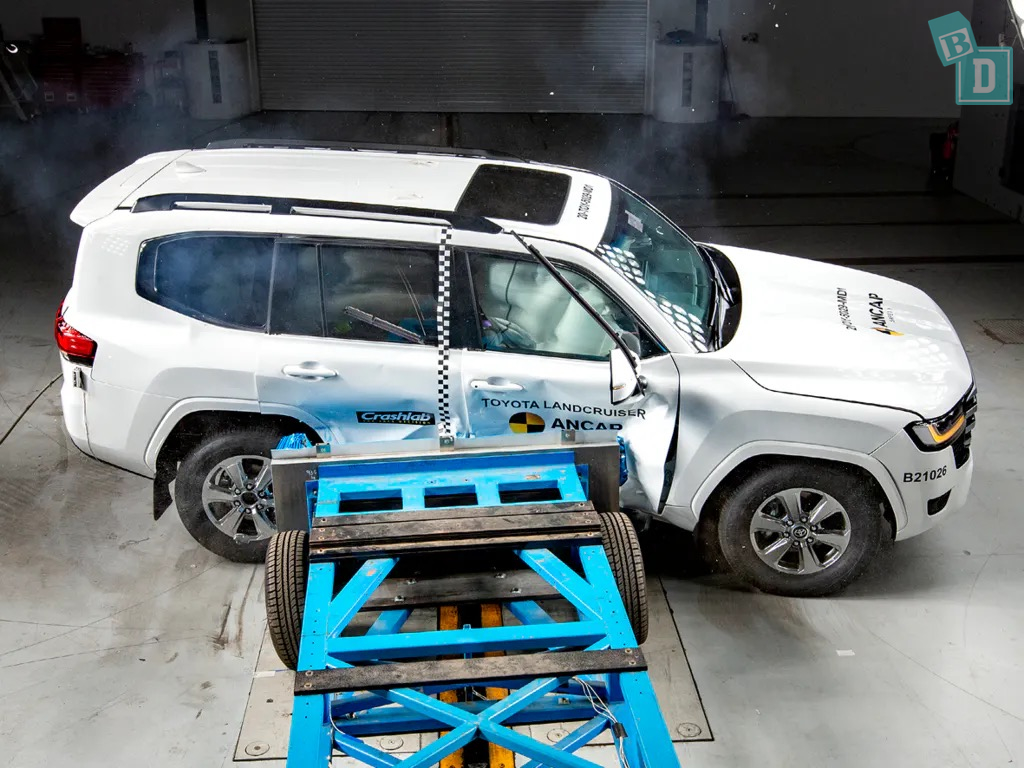
The Landcruiser 300 Series has eight airbags as standard:
Dual frontal, side chest-protecting and side head-protecting airbags, and driver and passenger knee airbags are standard. A centre airbag to prevent occupant-to-occupant interaction is not available.
There are also pretensioner seatbelts in the first and second-row outer seats only of the Toyota Landcruiser 300 Series (these are beneficial once your children are out of fully harnessed child seats).

This ANCAP child restraint fitting chart shows which types of child seats were able to be safely installed in the second-row seats of the Toyota Landcruiser 300 Series:
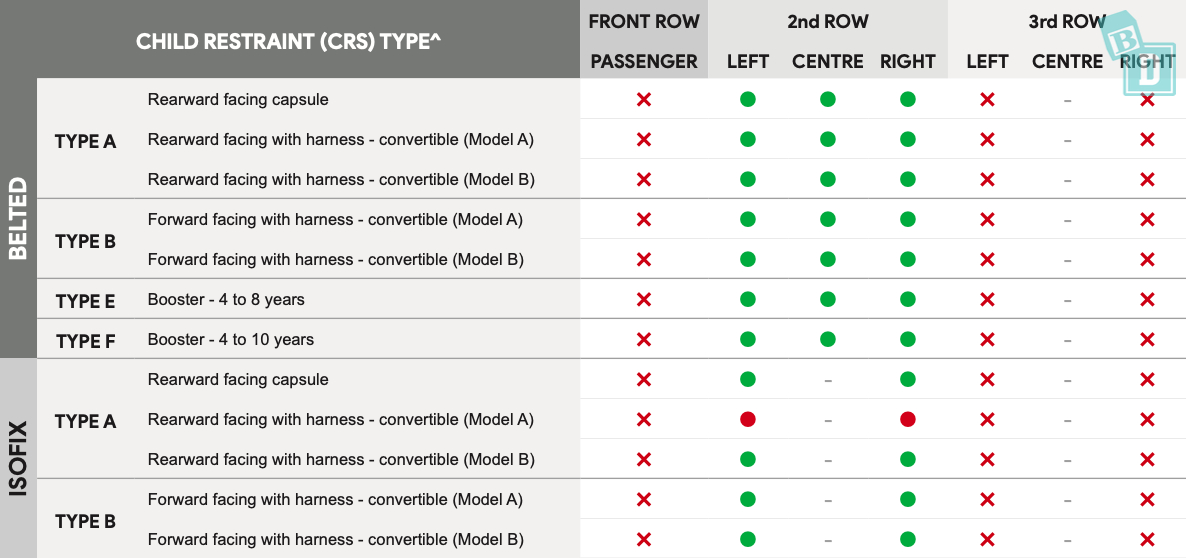
We also have to take the safety of the front passengers into account too when choosing our new family car, and the Toyota Landcruiser 300 Series did quite well in this, with a score of 34.09 out of 38 or 89% for Adult Occupant Protection with 7.36 out of 8 for the full-width frontal crash test, 4.90 out of 8 for the frontal offset crash test, full marks for both the pole test and the side impact test. Scoring 3.81 out of 4 for whiplash protection and full marks for far side impact and rescue and extraction.

8 – Genesis GV80 – Scores 88% for Child Occupant Protection
The Genesis GV80 is a luxury seven-seater family SUV.

Genesis GV80s with a build date of October 2020 onwards, scored 88% for child occupant protection, 3.41 out of 49 points. In the crash tests, it scored full points for both the dynamic front and dynamic side tests. The Genesis GV80 also got 11.60 out of 12 for child restraint installation and 8 out of 13 for on-board safety features. Making it a good choice for your rear passengers.

ANCAP wrote of the testing:
In both the frontal offset and side impact tests, protection was GOOD for all critical body areas for both the 6 year and 10 year child dummies.
The Genesis GV80 is fitted with lower ISOFix anchorages on the second row outboard seats and top tether anchorages for all second row seating positions. Top tethers are not available in the third row. Installation of child restraints in the third row is therefore not recommended.
Installation of typical child restraints available in Australia and New Zealand showed most child restraints could be accommodated in most second-row seating positions, though one of the selected Type A convertible seats could not be correctly installed in rearward facing mode using the ISOfix anchorages. In addition, care is required when installing a Type E booster in the second row centre position.

The Genesis GV80 has eight airbags as standard:
Dual frontal, side head-protecting airbags (1st, 2nd & 3rd rows) and side chest-protecting airbags, and a driver knee airbag are standard. A centre airbag to minimise occupant injury in a far-side impact crash is also fitted.
There are also pretensioner seatbelts in the first and second-row seats of the Genesis GV80 (these are beneficial once your children are out of fully harnessed child seats).

This ANCAP child restraint fitting chart shows which types of child seats were able to be safely installed in the second-row seats of the Genesis GV80:

We also have to take the safety of the front passengers into account too when choosing our new family car, and the Genesis GV80 did very well in this, with a score of 4.93 out of 38 or 91% for Adult Occupant Protection with 7.36 out of 8 for the full-width frontal crash test, 4.90 out of 8 for the frontal offset crash test, full marks for both the pole test and the side impact test. Scoring 3.81 out of 4 for whiplash protection and full marks for both the side impact and rescue and extraction tests.

9 – Toyota Kluger – Scores 88% for Child Occupant Protection
The Toyota Kluger is a large seven-seater family SUV.
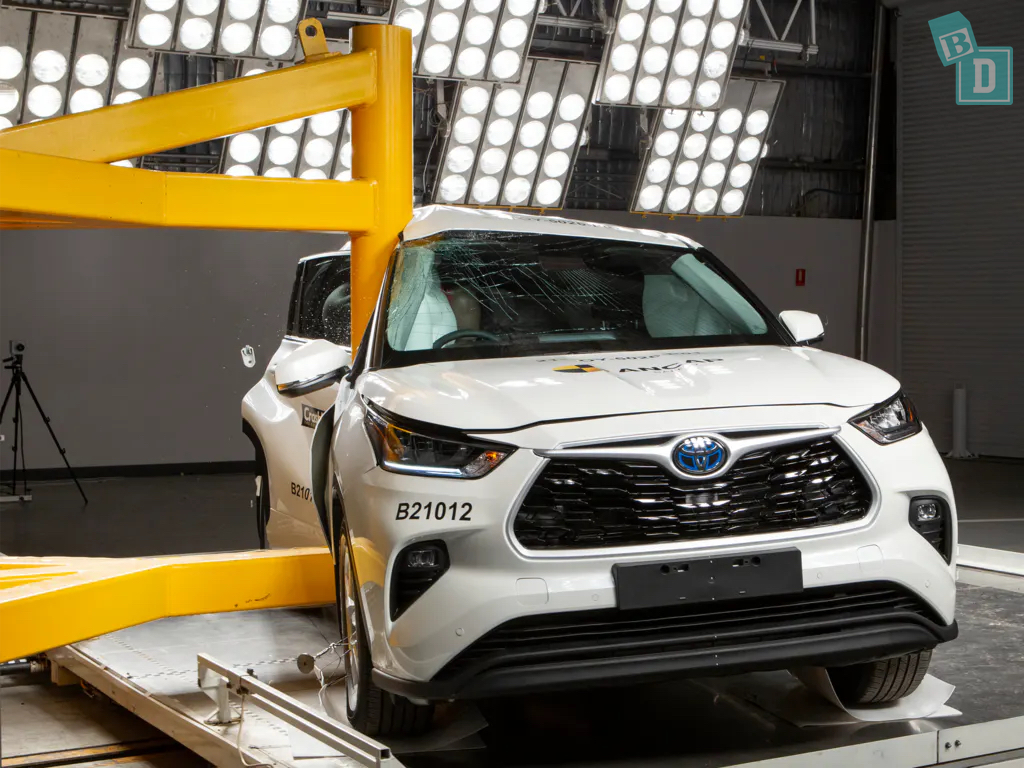
Klugers with a build date of March 2021 onwards, scored 88% for child occupant protection, 43.22 out of 49 points. In the crash tests, it scored full points for both the dynamic front and dynamic side tests. The Toyota Kluger also got 11.22 out of 12 for child restraint installation and 8 out of 13 for on-board safety features. Making it a good choice for your rear passengers.
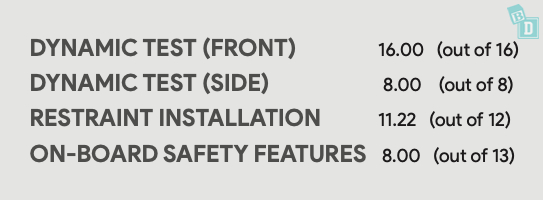
ANCAP wrote of the testing:
In the frontal offset (MPDB) and side impact tests, protection of the 10 year and 6 year dummies was GOOD for all critical body regions and maximum points were scored in these tests.
The Toyota Kluger is fitted with lower ISOFix anchorages for the outboard second row seating positions, and top tether anchorages for all second row seating positions. Neither top tether or ISOfix anchorages are available in the third row. Installation of child restraints in the third row is therefore not recommended.
Installation of typical child restraints available in Australia and New Zealand showed most child restraints could be accommodated in most second row seating positions, however one of the selected convertible seats could not be correctly installed in rearward- facing mode using the ISOfix anchorages in the outboard seats of the second row. Care is also required when using the seatbelt attachment when installing a rearward-facing baby capsule for the outboard second row positions.

The Toyota Kluger has seven airbags as standard:
Dual frontal, side head-protecting airbags (first, second & third rows), and side chest-protecting airbags (first row), and a driver knee airbag are standard. A centre airbag to minimise occupant injury in a far-side impact crash is not available.
There are also pretensioner seatbelts in the first and second-row outer seats of the Toyota Kluger (these are beneficial once your children are out of fully harnessed child seats).

This ANCAP child restraint fitting chart shows which types of child seats were able to be safely installed in the second-row seats of the Toyota Kluger:

We also have to take the safety of the front passengers into account too when choosing our new family car, and the Toyota Kluger did reasonably well in this, with a score of 34.53 out of 38 or 90% for Adult Occupant Protection with 7.63 out of 8 for the full-width frontal crash test, 7.10 out of 8 for the frontal offset crash test, full marks for both the pole test and the side impact test. Scoring 3.80 out of 4 for whiplash protection and full marks for both far side impact and rescue and extraction.

10 – Land Rover Defender – Scores 88% for Child Occupant Protection
The Land Rover Defender is a great seven-seater family SUV.
Land Rover Defenders with a build date of August 2020 onwards, scored 88% for child occupant protection, 43.22 out of 49 points. In the crash tests, it scored full points for both the dynamic front and dynamic side tests. The Land Rover Defender also got 11.22 out of 12 for child restraint installation and 10 out of 13 for on-board safety features. Making it a safe choice for your rear passengers.

ANCAP wrote of the testing:
In both the frontal offset (MPDB) and side impact tests, protection was GOOD for all critical body areas for both the 6 year and 10 year child dummies.
The Land Rover Defender is fitted with lower ISOFix anchorages on the second row outboard seats and top tether anchorages for all second row seating positions. Top tethers are not available in the optional third row. Installation of child restraints in the optional third row is therefore not recommended.
Installation of typical child restraints available in Australia and New Zealand showed most child restraints could be accommodated in most rear (2nd row) seating positions, however the Type A rearward-facing capsule could not be correctly installed in the 2nd row centre seating position. In addition, care is required when installing a Type E booster in the 2nd row centre seating position.

The Defender has seven airbags as standard:
Dual frontal, side chest-protecting for the first row and side head-protecting (curtain) airbags for both the first, second and optional third row are standard.
There are also pretensioner seatbelts in the first and second-row outer seats of the Land Rover Defender (these are beneficial once your children are out of fully harnessed child seats).

This ANCAP child restraint fitting chart shows which types of child seats were able to be safely installed in the second-row seats of the Land Rover Defender:

We also have to take the safety of the front passengers into account when choosing our new family car, and the Land Rover Defender did reasonably well in this, with a score of 32.51 out of 38 or 85% for Adult Occupant Protection with 7.35 out of 8 for the full-width frontal crash test, 4.36 out of 8 for the frontal offset crash test, full marks for both the pole test and the side impact test. Scoring 3.81 out of 4 for whiplash protection 2.99 out of 4 for far side impact and full marks for rescue and extraction.




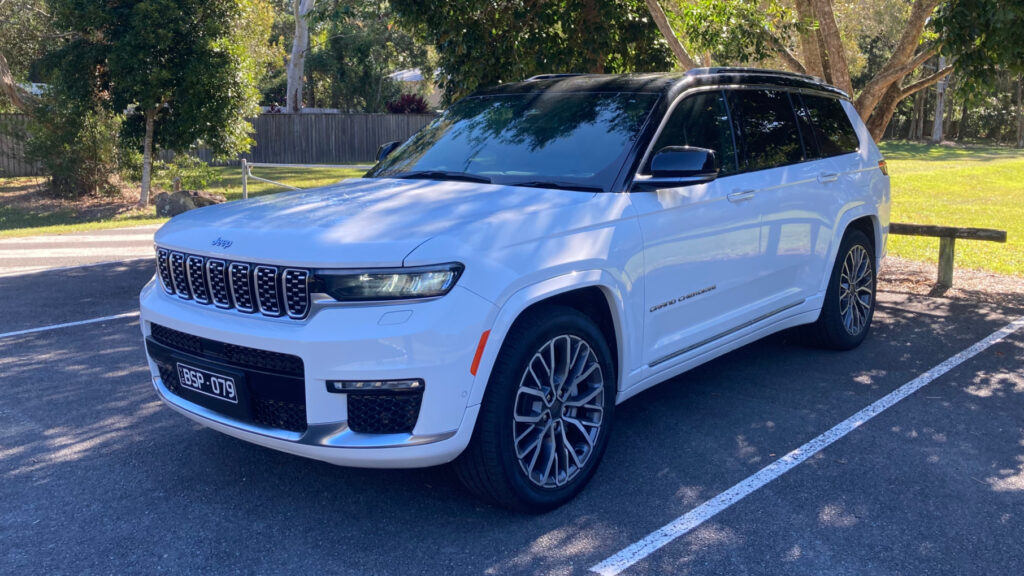
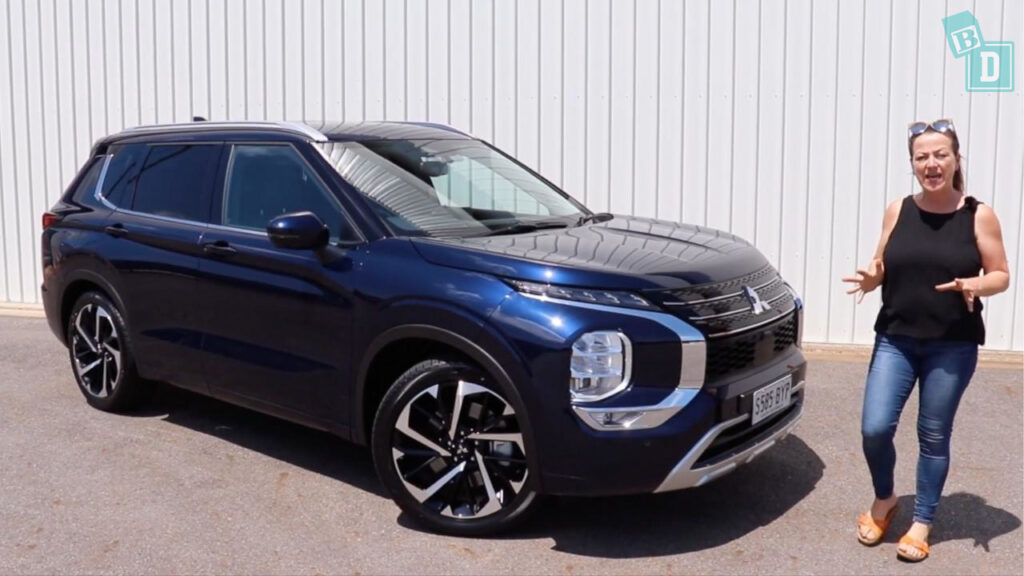


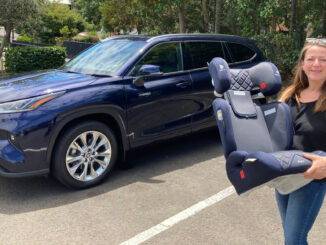
Be the first to comment